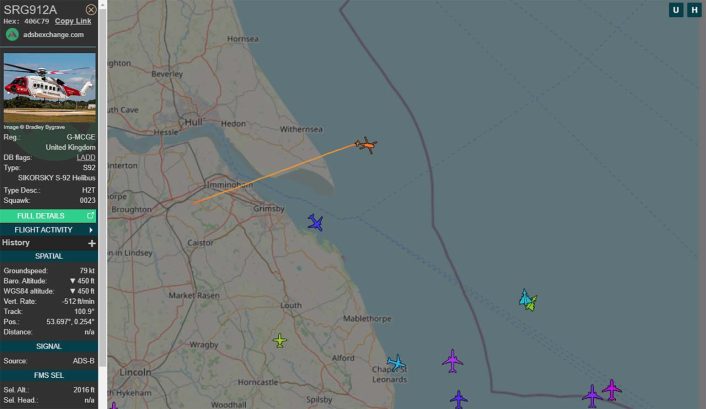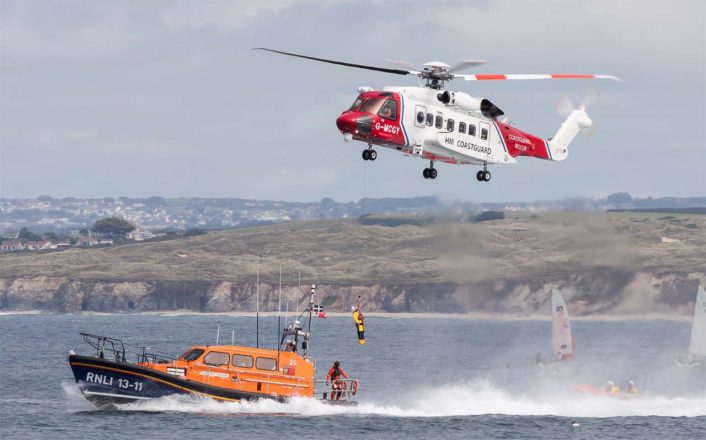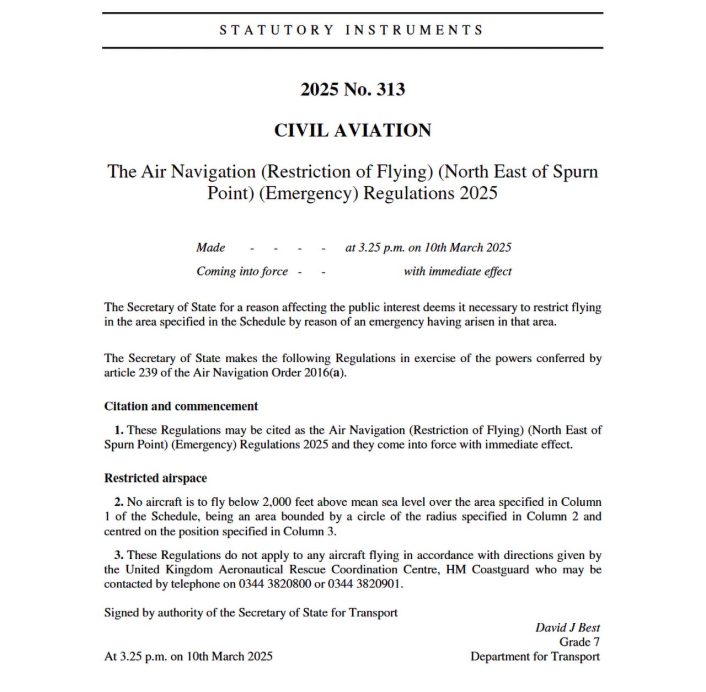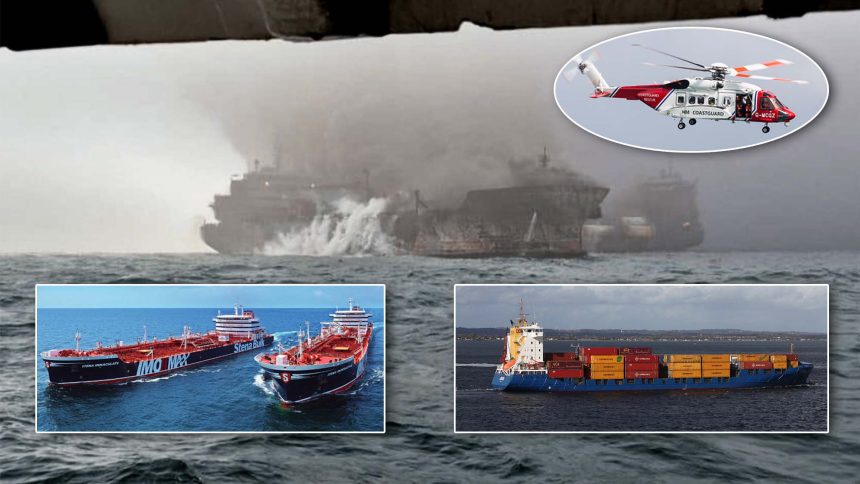On Mar. 10, 2025, container ship MV Solong collided with fuel tanker MV Stena Immaculate off the UK coast, triggering an extensive search and rescue response.
MV Solong, a container feeder ship registered in Portugal and owned by shipping firm Ernst Russ, departed Grangemouth, Scotland, on a common route to the major Dutch port of Rotterdam. As the ship travelled south along the coastline it approached MV Stena Immaculate, a tanker that was reportedly chartered by the U.S. Department of Defense (DoD), at anchor.
The container vessel struck the tanker on its port side at 0948 UTC, causing significant damage to both vessels. A fire subsequently ignited, and some crew members elected to abandon ship. Prior weather reports suggested the area was afflicted by fog at the time of the collision, which may have affected the situational awareness of the crew aboard each vessel. Both vessels were transmitting full Automatic Identification System (AIS) information, which allows them to track each other accurately as well as be tracked by online websites such as MarineTraffic.
From Marine Traffic, here’s the moment of the crash between the oil tanker MV Stena Immaculate and a cargo vessel MV Solong. Live updates here www.theguardian.com/uk-news/live…
[image or embed]
— Eliot Higgins (@eliothiggins.bsky.social) March 10, 2025 at 1:08 PM
HM Coastguard were alerted to the incident almost immediately and called on nearby vessels, which included a number of offshore support vessels that frequent the North Sea oil fields, to render assistance. These ships are remarkably seaworthy platforms equipped with high tech station-keeping systems, medical facilities, launchable boats, and firefighting capabilities, allowing them to serve as ‘survivor’ vessels in case of a major incident on board an oil rig.
A Sikorsky S-92 search and rescue (SAR) helicopter using the callsign ‘Coastguard Rescue 912 Alpha’, operated by Bristow Group on behalf of the Coastguard, was launched from Humberside Airport and arrived on scene by 1030 UTC. This is the largest helicopter type operated under the SAR helicopter contract, and complements its sizeable survivor capacity with a Star Safire 380HD forward looking infrared (FLIR) turret, night vision goggles, 1200 watt loudhailer, medical equipment, and a full auto-hover system.

A fixed wing Beechcraft B200 King Air, also operated for HM Coastguard, was also dispatched shortly afterwards. Top cover and surveillance was provided by this aircraft throughout the day. Fixed wing aircraft operations by HM Coastguard were expanded in the new SAR2G contract, which will also see the service equipped with Scheibel S-100 Camcopter unmanned aerial vehicles.
Four stations of the Royal National Lifeboat Institution (RNLI), a charity that provides waterborne rescues across the United Kingdom and Republic of Ireland, were activated at 1020 UTC and their boats dispatched. Two of these, Bridlington and Skegness, are equipped with state of the art long range Shannon class all weather lifeboats which can carry up to 79 survivors, or 23 while maintaining the ability to self-right after capsizing.

Local Member of Parliament Graham Stuart confirmed in the afternoon that 36 members of crew across both vessels had been located and accounted for, with only one hospitalised for injuries sustained. At the time of writing, one member of crew from MV Solong is still missing, with SAR efforts continuing in an effort to locate them.
Crowley Maritime, who manage the MV Stena Immaculate, confirmed that the ship suffered multiple explosions following the incident, which they referred to as an ‘allision’. In strict nautical terms, an allision is where a ship collides with a stationary ship or object, while a collision involves two moving vessels.
The company also confirmed that the ship was carrying Jet A-1 aviation fuel, and that the tank carrying this fuel had ruptured. Coastguard radio alerts via the maritime distress frequency stated that the fuel had spilled from the vessel and was on fire. A call for assistance from vessels with a firefighting capability was made.
At 1525 UTC, an Air Navigation Order was made restricting the airspace above and in a 3 nautical mile radius around the incident location up to 2000 feet. Within this area, only air traffic operating with the permission of the UK Aeronautical Rescue Coordination Centre (ARCC) are permitted. These restrictions are commonly made for major incidents to safeguard the aircraft working as part of the incident response. The need for such restrictions became apparent to the world when a firefighting aircraft operating over California hit an unauthorised drone, leading to a temporary grounding.
The Notice to Aviation (NOTAM) enforcing this order is currently valid until Mar. 17, although this could be withdrawn earlier if no longer required.

A maritime exclusion zone was additionally declared, with a radius of 1000 metres centred on the position of MV Stena Immaculate, forbidding entry for any vessels not part of the rescue or incident response operation. A number of tug boats and offshore support vessels still, at the time of writing, surround the two ships, although a large number have now retreated to the Humber estuary.

Cleanup operations for both the spilled jet fuel as well as the marine fuel from the ships themselves are sure to commence as soon as possible. Alongside vessels operating on the ocean surface, aircraft may be deployed to spray dispersants into the water which help to break up the polluting chemicals.
A collection of aircraft are contracted by the UK government to provide this service, with a Cessna F406 offering a small scale spill response or test spray capability, and two Boeing 737-400s that can be equipped with an Oil Dispersant Spray Kit and 15,900 litres of dispersant agent. Two Boeing 727s are also based at London Southend Airport available for oil spill response operations worldwide, which could be called in as additional support.
The required counter-pollution response is currently being assessed by HM Coastguard as environmental groups draw particular attention to this matter. Large oil spill incidents, while uncommon in the UK, are well remembered for causing massive devastation to coastal communities and the surrounding wildlife.
The 1967 Torrey Canyon disaster off the coast of Cornwall saw over 100,000 tonnes of crude oil pollute the seas and kill an estimated 30,000 birds. Remnants of this spill can still be seen along the UK’s south coast to this day. Dispersal efforts at the time were relegated largely to aerial bombing by the Royal Air Force and Fleet Air Arm in an attempt to burn the oil before it reached the shore.
Not only is the fuel causing a concern, but it is reported that among MV Solong’s cargo was a shipment of sodium cyanide, a highly toxic substance. It is not yet known how much, if any, of this compound has entered the water.
MV Stena Immaculate and the U.S. Military
Widely reported in coverage of this incident is the status of MV Stena Immaculate as under contract to the U.S. Department of Defense, which is a clear explanation of its Jet A-1 fuel cargo. While the U.S. operates a sizeable tanker force as part of its auxiliary fleet, additional civilian support is often required to adequately supply all of the military’s global operations. Under the Tanker Security Program, a minimum of ten civilian tanker vessels must be made available to the U.S. military when required.
While the ships enrolled in the program are required to meet the condition of being suitable for use during times of national emergency or armed conflict, these are not prerequisites for the chartering of these vessels for military use. Three tankers operated by Stena-Crowley were enrolled in the program in 2023.
The use of civilian tankers under contract to military forces is not a new concept, and in fact has been a regular practice for the UK Ministry of Defence who use fuel tankers under long term charter to transport fuel between the UK and overseas bases such as RAF Akrotiri.
A U.S. Government official commenting on the incident has reportedly said ‘foul play’ has not yet been ruled out, although no indications that would suggest such a cause are yet apparent. As in aviation, and proven by the recent collision involving the USS Harry S. Truman, even the most technologically well equipped and protected vessels in the world can suffer from accidents at sea.









